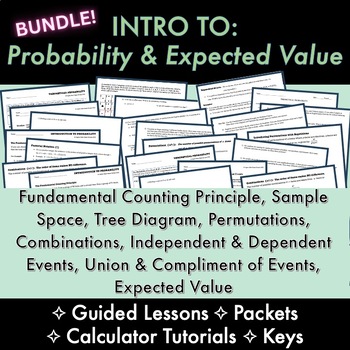INTRO to Probability & Expected Value - LESSONS, WORKSHEETS, PACKETS, KEYS
- Zip
Products in this Bundle (3)
Description
➤ LESSON 1: Intro to probability full 2 to 3-day GUIDED-NOTES lesson packet, 40 total exercises (can be used as classwork and/or homework), notes and step-by-step answer keys. What is the Fundamental Counting Principle? Definition and connection to Sample Space and Tree Diagrams. What is permutation vs. combination, and when do we use them? Students learn what a factorial is through flawless connections to fundamental counting principle and permutations, and how to simplify factorials without using calculators. Students learn the difference, and how/when to use the permutation vs. combination formulas as well as how to use on calculators. Students also learn permutations with duplicate items (repetition).
➤ LESSON 2: Theoretical Probabilities - Probability of an Event P(E), Independent vs. Dependent Events formulas, difference between a probability With vs. Without Replacement, formulas of probability for the Union and Complement of an event. Finding theoretical probabilities using tree diagrams, sample space, and fundamental counting principle to help. Examples include topics of dice, coins, marbles, deck of cards, and much more!
➤ LESSON 3: How to find the expected value using the formula in statistics and probability. Students learn how to find the expected value of one event vs. multiple events, and using that value to solve Games of Chance problems (using expected value to understand the outcome of a game in which a player could either win or lose money in a game. Students in some of these real-world problems need prior knowledge of theoretical probability.
--------------------------------
You might also be interested in my:
✫ 11-Page PRETEST [Research-Based]
--------------------------------
INCLUDED:
✫ Step-by-step answer keys with notes to EVERYTHING!
✫ Calculator tutorials
✫ 2 Fully scaffolded guided-lesson packets [12 pages total] which also include a total of 70 exercises using both formulas & the calculator for Fundamental Counting Principle, permutations and combinations problems
✫ 1 guided-lesson worksheet of Expected Value lesson
✫ 3-page packed independent work packet (31 problems total)
✫ 2 double-sided homework worksheets (24 problems total)
--------------------------------
STUDENTS WILL BE ABLE TO:
➤ Know all definitions, formulas, and calculator skills (factorial, permutations and combinations)
➤ Know what a sample space is in connection to a Tree Diagram and Fundamental Counting Principle
➤ Find the number of ways a group of objects can be arranged
➤ Find the number of ways to choose several objects from a group where order does not matter
➤ How to find permutations of duplicate or repeated items
➤ Make deep connections
➤ Apply the formula for a Probability of an Event P(E)
➤ Apply the formula for a Union of an Event
➤ Apply the formula for an Independent (with replacement) vs. Dependent (without replacement) Event
➤ Apply the formula for a Complement of an Event
➤ Use a Tree Diagram and Sample Space to determine a probability of an event
➤ Use the formula to find the expected value of one event & multiple events
➤ Use prior knowledge of theoretical probability to compute expected value.
➤ Use expected value in "games of chance" problems. For example, if a game is favorable vs. unfavorable for a player to play a particular game (gambling, etc.)


